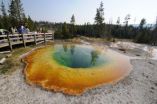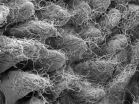(Press-News.org) BELLINGHAM, Washington, USA -- "Nature has developed, very cleverly, some lessons on how to create the features that we desire in optical design," said Joseph Shaw, director of the Optical Technology Center at Montana State University. "As we explore surfaces and structures at the nanoscale, we'll discover them."
Some of those lessons were presented in San Diego in August during a conference called "The Nature of Light: Light in Nature" chaired by Shaw and Rongguang Liang of the University of Arizona College of Optical Sciences. The conference was part of SPIE Optics + Photonics, sponsored by SPIE, the international society for optics and photonics.
The conference is particularly relevant as the optics and photonics community prepares for the United Nations International Year of Light 2015, Shaw said. "Such lessons from nature not only remind us of how light-based technologies touch all of our lives and help solve challenges in energy, healthcare, communications, and other areas, but they also remind us to pause and appreciate the visual beauty found throughout nature."
Shaw, whose research as a professor in electrical and computer engineering involves developing optical sensors for applications ranging from imaging of clouds to laser-detection of fish, said that observing how nature solves problems is particularly helpful for optical designers and engineers working with very small structures.
Insect wings that absorb all of the visible light spectrum and iridescent shells, for example, each possess optical surfaces that might find design applications one day, perhaps as camouflage.
Some wings have antireflective cone-like structures of a few nanometers that absorb virtually the entire visible spectrum, a team from the University of Namur (Louis Dellieu, et al.) reported. In the grey cicada, absorption is a product of the distinctive shape of tiny surface cones.
Iridescence of the lining of mollusk shells was explored by a team from Colgate University (R. A. Metzler, et al.), who reported on the polarization effects of the lining, known as nacre, or mother of pearl. It consists of up to 30,000 layers of tiny calcium carbonate "bricks" – just 0.5 microns, or a 200th of the diameter of a human hair -- held together by a "mortar" of organic chitin. Reflected light from the lining produces the shells familiar array of colors.
"We have the tools for nanoengineering and nanoexploration," Shaw said. "We can do reverse engineering of the structures."
Color of vivid blue pools, some as hot as 250 degrees Fahrenheit, at Yellowstone National Park in Wyoming and Montana has only little to do with reflection of sky light, a paper by Shaw and others reported. The blue comes from the scatter of particles in the water. The deeper the water, the more dominant the scatter and the richer the blue. Red, orange, and yellow colors of other pools are driven by varieties of microbes on the rock surfaces under the water and related to the temperature of water in each pool.
Applications of these findings could include using a color imager to infer information about such pools and their resident microbe communities and what causes their presence. This could connect with NASA-funded research, because of the similarity of Yellowstone microbes with possible early forms of life on Earth and other planets. Ongoing Yellowstone research is even exploring how these microbes might inspire development of alternative fuels.
Optical labs looking for higher-efficiency solar cells or light-emitting diodes (LEDs) might one day use genetic algorithms to streamline their work. A team from Namur University of Namur (Alexandre Mayer, et al.), noting that thinking through a design question could mean millions or billions of options to check, demonstrated that a genetic algorithm can quickly make many small changes. A lab might need to explore only a few hundred options instead of millions. The genetic algorithm would work the way natural evolution does: scanning all the possibilities and quickly narrowing down the search.
Insights from models involving the speed of light for learning about the geometry of space-time (James Cole, University of Tsukuba)
Spider interactions with objects to learn about the structure of color and color-producing elements (Bor-Kai Hsiung, University of Akron)
Fabricating nanostructures inspired by the blue Morpho butterfly wing, replicating the wing's color and water-repellent qualities (Radwanul Siddique, Karlsruher Institut für Technologie, et al.)
INFORMATION:
Conference proceedings are now in publication, with papers going up in the SPIE Digital Library as soon as each is approved.
SPIE is the international society for optics and photonics, a not-for-profit organization founded in 1955 to advance light-based technologies. The Society serves nearly 256,000 constituents from approximately 155 countries, offering conferences, continuing education, books, journals, and a digital library in support of interdisciplinary information exchange, professional networking, and patent precedent. SPIE provided more than $3.2 million in support of education and outreach programs in 2013. END
Nature's designs inspire research into new light-based technologies
Seashells and electromagnetic waves, spiders and the structure of color connect in optics and photonics studies
2014-09-17
ELSE PRESS RELEASES FROM THIS DATE:
In Joslin trial, Asian Americans lower insulin resistance on traditional diet
2014-09-17
BOSTON – September 17, 2014 – Why are Asian Americans at higher risk of developing type 2 diabetes than Caucasian Americans, and prone to develop the disease at lower body weights? One part of this puzzle may lie in the transition from traditional high-fiber, low-fat Asian diets to current westernized diets, which may pose extra risks for those of Asian heritage, says George King, M.D., Senior Vice President and Chief Scientific Officer at Joslin Diabetes Center and the senior author of the study.
A Joslin randomized clinical trial now has demonstrated that both Asian ...
Fighting parents hurt children's ability to recognize and regulate emotions
2014-09-17
Exposure to verbal and physical aggression between parents may hurt a child's ability to identify and control emotions, according to a longitudinal study led by NYU's Steinhardt School of Culture, Education, and Human Development.
The findings, which appear in the journal Development and Psychopathology, also suggest that household chaos and prolonged periods of poverty during early childhood may take a substantial toll on the emotional adjustment of young children.
"Our study points to ways in which aggression between parents may powerfully shape children's emotional ...
Persian Gulf states have new role to play in Israeli-Palestinian conflict resolution
2014-09-17
HOUSTON – (Sept. 17, 2014) – The shifting regional geopolitics of the Middle East have created new opportunities for the Persian Gulf states to engage in Arab-Israeli conflict resolution, according to a new paper from Rice University's Baker Institute for Public Policy.
"The Gulf States and Israeli-Palestinian Conflict Resolution," authored by Kristian Coates Ulrichsen, proposes a set of policy recommendations on how the Gulf states can engage with regional and international partners to create new pathways for action and cooperation. Ulrichsen is the fellow for the Middle ...
Why bioethics literacy matters
2014-09-17
From accessible and affordable health care to reproductive technologies, the justice and well-being of our society depend on the ability of people to identify key issues, articulate their values and concerns, deliberate openly and respectfully, and find the most defensible ways forward. But what are the best educational practices to support these societal conversations?
The Hastings Center and the Presidential Commission for the Study of Bioethical Issues have teamed up to publish a series of essays to highlight the best practices in teaching bioethics and to identify ...
Smallest known galaxy with a supermassive black hole
2014-09-17
SALT LAKE CITY, Sept. 17, 2014 – A University of Utah astronomer and his colleagues discovered that an ultracompact dwarf galaxy harbors a supermassive black hole – the smallest galaxy known to contain such a massive light-sucking object. The finding suggests huge black holes may be more common than previously believed.
"It is the smallest and lightest object that we know of that has a supermassive black hole," says Anil Seth, lead author of an international study of the dwarf galaxy published in Thursday's issue of the journal Nature. "It's also one of the most black ...
Gut bacteria, artificial sweeteners and glucose intolerance
2014-09-17
Artificial sweeteners, promoted as aids to weight loss and diabetes prevention, could actually hasten the development of glucose intolerance and metabolic disease; and they do it in a surprising way: by changing the composition and function of the gut microbiota – the substantial population of bacteria residing in our intestines. These findings, the results of experiments in mice and humans, were published today in Nature. Among other things, says Dr. Eran Elinav of the Weizmann Institute's Immunology Department, who led this research together with Prof. Eran Segal of Computer ...
New branch added to European family tree
2014-09-17
The setting: Europe, about 7,500 years ago.
Agriculture was sweeping in from the Near East, bringing early farmers into contact with hunter-gatherers who had already been living in Europe for tens of thousands of years.
Genetic and archaeological research in the last 10 years has revealed that almost all present-day Europeans descend from the mixing of these two ancient populations. But it turns out that's not the full story.
Researchers at Harvard Medical School and the University of Tübingen in Germany have now documented a genetic contribution from a third ancestor: ...
Natural born killers: Chimpanzee violence is an evolutionary strategy
2014-09-17
ANN ARBOR—Man's nearest relatives kill each other in order to eliminate rivals and gain better access to territory, mates, food or other resources—not because human activities have made them more aggressive.
That is the conclusion of an international analysis of lethal aggression among different groups of chimpanzees in Africa studied over five decades. The research appears in the current issue of Nature.
"Observations that chimpanzees kill members of their own species have influenced efforts to understand the evolution of human violence," said University of Michigan ...
What set the Earth's plates in motion?
2014-09-17
The mystery of what kick-started the motion of our earth's massive tectonic plates across its surface has been explained by researchers at the University of Sydney.
"Earth is the only planet in our solar system where the process of plate tectonics occurs," said Professor Patrice Rey, from the University of Sydney's School of Geosciences.
"The geological record suggests that until three billion years ago the earth's crust was immobile so what sparked this unique phenomenon has fascinated geoscientists for decades. We suggest it was triggered by the spreading of early ...
Nature of war: Chimpanzees inherently violent according to study
2014-09-17
(Chicago) -- Of all of the world's species, humans and chimpanzees are some of the only to engage in coordinated attacks on other members of their same species. Jane Goodall was among the first to introduce the occurrence of lethal inter-community killings and since then primatologists and anthropologists have long debated the concept of warfare in this genus. Research theories have pointed to increased gains and benefits of killing off competitors and opening up increased access to key resources such as food or mates. In contrast, others have argued that warfare is a result ...
LAST 30 PRESS RELEASES:
Injectable breast ‘implant’ offers alternative to traditional surgeries
Neuroscientists devise formulas to measure multilingualism
New prostate cancer trial seeks to reduce toxicity without sacrificing efficacy
Geometry shapes life
A CRISPR screen reveals many previously unrecognized genes required for brain development and a new neurodevelopmental disorder
Hot flush treatment has anti-breast cancer activity, study finds
Securing AI systems against growing cybersecurity threats
Longest observation of an active solar region
Why nail-biting, procrastination and other self-sabotaging behaviors are rooted in survival instincts
Regional variations in mechanical properties of porcine leptomeninges
Artificial empathy in therapy and healthcare: advancements in interpersonal interaction technologies
Why some brains switch gears more efficiently than others
UVA’s Jundong Li wins ICDM’S 2025 Tao Li Award for data mining, machine learning
UVA’s low-power, high-performance computer power player Mircea Stan earns National Academy of Inventors fellowship
Not playing by the rules: USU researcher explores filamentous algae dynamics in rivers
Do our body clocks influence our risk of dementia?
Anthropologists offer new evidence of bipedalism in long-debated fossil discovery
Safer receipt paper from wood
Dosage-sensitive genes suggest no whole-genome duplications in ancestral angiosperm
First ancient human herpesvirus genomes document their deep history with humans
Why Some Bacteria Survive Antibiotics and How to Stop Them - New study reveals that bacteria can survive antibiotic treatment through two fundamentally different “shutdown modes”
UCLA study links scar healing to dangerous placenta condition
CHANGE-seq-BE finds off-target changes in the genome from base editors
The Journal of Nuclear Medicine Ahead-of-Print Tip Sheet: January 2, 2026
Delayed or absent first dose of measles, mumps, and rubella vaccination
Trends in US preterm birth rates by household income and race and ethnicity
Study identifies potential biomarker linked to progression and brain inflammation in multiple sclerosis
Many mothers in Norway do not show up for postnatal check-ups
Researchers want to find out why quick clay is so unstable
Superradiant spins show teamwork at the quantum scale
[Press-News.org] Nature's designs inspire research into new light-based technologiesSeashells and electromagnetic waves, spiders and the structure of color connect in optics and photonics studies




